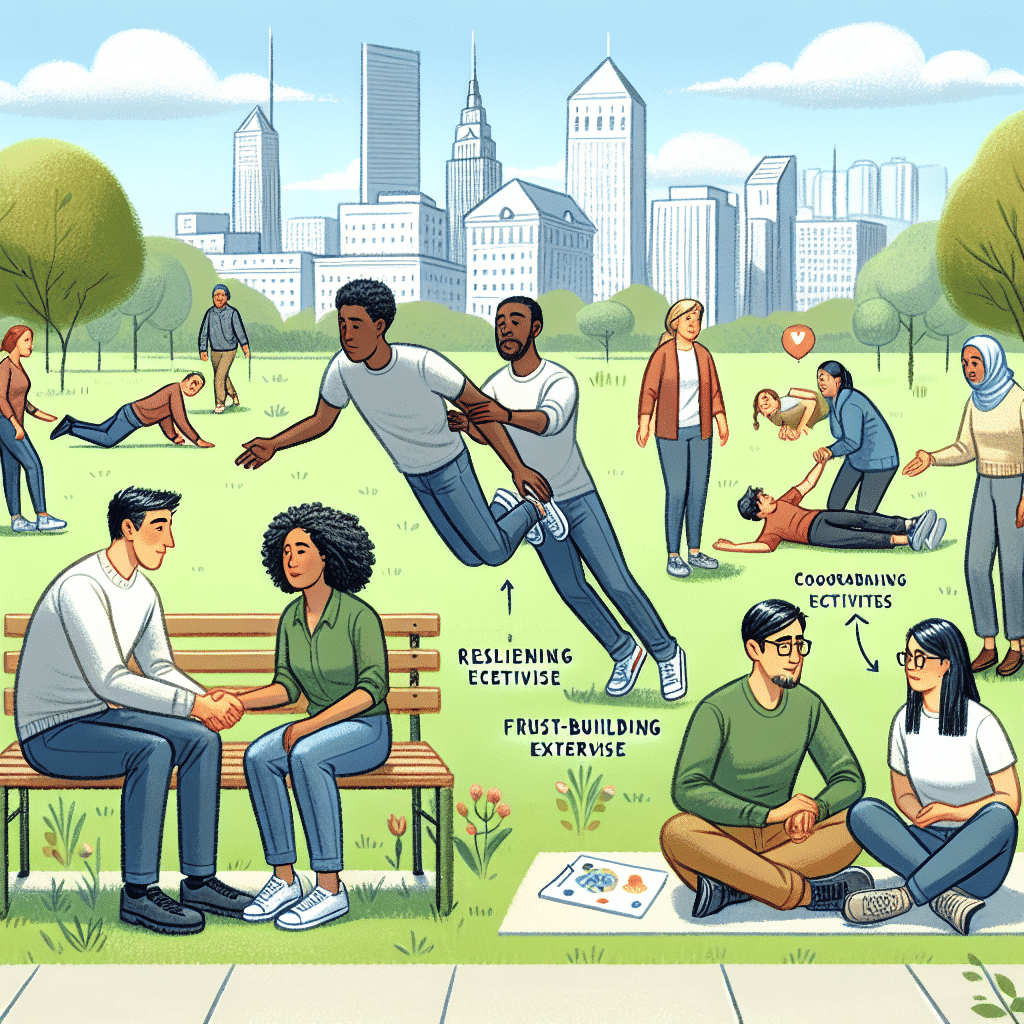
Understanding Confidence Building
Confidence building is a crucial aspect of community building as it plays a significant role in creating a sense of trust, collaboration, and unity among community members. It is the process of instilling self-assurance and belief in individuals and the collective group, fostering an environment where everyone feels empowered and valued.
Confidence building involves both enhancing individuals’ self-esteem and creating a supportive community space where everyone feels included and heard. It requires promoting a positive and encouraging atmosphere where people feel comfortable expressing themselves and taking risks.
When confidence is built within a community, it paves the way for individuals to actively participate, contribute ideas, and work together towards common goals. It boosts motivation and engagement, leading to stronger relationships and a more closely-knit community.
Now, let’s explore the importance of confidence building for community building.
Importance of Confidence Building for Community Building
Confidence building plays a crucial role in the process of community building. It fosters a sense of trust, unity, and cooperation among community members, ultimately leading to the development of a strong and resilient community. When individuals within a community feel confident and supported, they are more likely to actively participate in community initiatives, take on leadership roles, and contribute their skills and resources to the betterment of the community as a whole.
One of the key benefits of confidence building in community building is the creation of a supportive and inclusive environment. When community members feel a sense of belonging and acceptance, they are more likely to engage in open and constructive dialogue, share their ideas and opinions, and actively collaborate with others. This leads to a greater diversity of perspectives and a more inclusive decision-making process, ultimately resulting in better outcomes for the community.
Moreover, confidence building promotes a culture of empowerment and motivation within a community. When individuals feel confident in their abilities and believe that their contributions matter, they are more likely to take initiative, seek out opportunities for personal growth and development, and become agents of positive change. This, in turn, creates a ripple effect where others in the community are inspired and motivated to do the same, creating a cycle of continuous growth and improvement.
Furthermore, confidence building helps to build resilience within a community. In the face of challenges and setbacks, a confident community is better equipped to come together, adapt, and overcome obstacles. By fostering a sense of belief in their collective abilities, community members can navigate through difficult times with resilience and determination, finding innovative solutions and working together to build a better future.
Overall, confidence building is a critical component of community building as it establishes a strong foundation of trust, unity, and cooperation among community members. By nurturing a supportive and inclusive environment, promoting empowerment and motivation, and fostering resilience, communities can thrive and achieve their shared goals. Therefore, investing time and effort into confidence building initiatives is essential for creating cohesive and thriving communities.
Strategies for Building Confidence in a Community
Building confidence in a community is essential for fostering a strong and cohesive environment. It not only encourages individuals to actively participate and contribute to the community but also promotes a sense of belonging and trust among its members. Here are some effective strategies to build confidence in a community:
1. Encourage Open Communication
Open communication is vital for building trust and confidence in a community. Encourage community members to express their ideas, concerns, and feedback in a safe and non-judgmental environment. Implement platforms such as community forums, suggestion boxes, or virtual meetings where everyone can freely share their thoughts.
2. Provide Opportunities for Skill Development
Empower community members by offering opportunities for skill development. Organize workshops, seminars, or training programs to enhance their abilities and knowledge in areas that align with the community’s goals and interests. This not only boosts individuals’ confidence but also adds value to the community as a whole.
3. Recognize and Celebrate Achievements
Recognizing and celebrating achievements is an important aspect of building confidence in a community. Show appreciation for individual and collective accomplishments, whether big or small. This can be done through awards, certificates, public acknowledgments, or even small gestures like thank-you notes. Celebrating achievements fosters a positive atmosphere and motivates community members to continue their efforts.
4. Foster Collaboration and Teamwork
Promote collaboration and teamwork within the community as it enhances confidence and builds stronger relationships. Encourage members to work together on community projects, initiatives, or events. This creates a sense of unity, shared responsibility, and accomplishment, boosting individual and overall community confidence.
5. Provide Support and Encouragement
Offer support and encouragement to community members who may feel uncertain or lacking in confidence. Create mentorship programs or buddy systems where experienced individuals can guide and provide assistance to those who need it. By offering support, individuals feel valued and motivated, leading to an increase in their confidence levels.
6. Foster a Positive and Inclusive Environment
Cultivate a positive and inclusive environment that welcomes diversity and different perspectives. Ensure that everyone feels respected, heard, and included. Establish clear guidelines and policies against discrimination, harassment, or bullying, and take appropriate actions when necessary. A positive and inclusive environment encourages individuals to contribute confidently and builds trust within the community.
By employing these strategies, community leaders and members can actively contribute to building confidence within their community. With boosted confidence, individuals feel empowered to actively participate, explore new ideas, and collaborate with others, ultimately leading to a stronger and more vibrant community.

IV. Overcoming Challenges in Confidence Building
1. Addressing Communication Barriers
One of the biggest challenges in confidence building is overcoming communication barriers within a community. Language differences, cultural misunderstandings, and lack of effective communication channels can hinder trust and confidence. To address these challenges, it is essential to:
- Provide translation services or interpreters to facilitate communication among community members who speak different languages.
- Organize cultural exchange programs or events to promote understanding and reduce misunderstandings.
- Establish clear communication channels, such as community websites, social media groups, or regular community meetings, to ensure that information is accessible to everyone.
2. Encouraging Active Participation
An empowered community is one where every member feels valued and has a sense of ownership. Encouraging active participation can help overcome challenges in confidence building. Here are some strategies to foster participation:
- Involve community members in decision-making processes and give them opportunities to contribute their ideas and opinions.
- Create platforms for community members to share their skills and talents, such as workshops, seminars, or volunteer programs.
- Recognize and celebrate the achievements and efforts of community members to boost their confidence and motivation.
3. Building Trust through Transparency
Transparency is crucial in building confidence within a community. It helps establish trust and ensures that community members have faith in the actions and decisions of their leaders. To build trust through transparency:
- Share information openly and honestly, keeping community members informed about the progress, challenges, and goals of community-building initiatives.
- Encourage feedback and suggestions from community members, and actively address any concerns or grievances they may have.
- Hold regular meetings or forums where community leaders are available to answer questions and address concerns in a transparent manner.
4. Promoting Collaboration and Cooperation
Collaboration and cooperation among community members are essential for confidence building. By working together towards common goals, community members can develop a sense of unity and belonging. To promote collaboration and cooperation:
- Create opportunities for community members to collaborate on projects or initiatives that benefit the community as a whole.
- Organize team-building activities or workshops that encourage teamwork and foster a sense of camaraderie.
- Establish support networks within the community, where members can seek assistance or advice from one another.
5. Providing Continuous Support and Resources
Confidence building is an ongoing process that requires continuous support and access to resources. Providing the necessary support and resources can help community members feel empowered and confident in their ability to contribute. Some ways to provide continuous support and resources include:
- Offer training programs or workshops to enhance the skills and knowledge of community members.
- Provide access to funding or grants for community projects or initiatives.
- Establish mentoring programs where experienced community members can guide and support those who are new or less confident.
Promoting Long-Term Confidence in Community Building
Building confidence in a community is not a one-time event, but rather an ongoing process that requires a long-term commitment. Here are some strategies to promote long-term confidence in community building:
1. Foster a sense of belonging
A strong sense of belonging is essential for building confidence in a community. Encourage active participation and engagement among community members by creating opportunities for collaboration, sharing ideas, and working towards common goals. This can be achieved through organizing regular meetings, workshops, or events where people can come together, connect, and build relationships.
2. Provide consistent support and resources
Providing consistent support and resources is crucial for sustaining confidence in a community. Community leaders and organizations should continuously assess the needs and aspirations of the community and provide the necessary resources to address them. This could include access to education, healthcare, infrastructure, or even financial assistance for community development projects.
3. Encourage open communication
Open and honest communication is essential for building trust and confidence within a community. Create platforms for community members to voice their concerns, ideas, and opinions. This could be through town hall meetings, online forums, or social media groups. Encourage active listening, respectful dialogue, and inclusivity in these communication channels to foster a sense of ownership and accountability.
4. Recognize and celebrate achievements
Recognizing and celebrating the achievements of community members is an effective way to boost confidence and morale. This can be done through awards, certificates, or public acknowledgments. By highlighting the positive impact individuals have made in the community, others are inspired and motivated to contribute their skills and talents as well.
5. Foster leadership and empowerment
Empowering community members to take on leadership roles and contribute to decision-making processes is vital for building long-term confidence. Encourage individuals to step up and take charge of community initiatives or projects. Provide training and mentorship opportunities to help develop their skills, knowledge, and confidence in their abilities. This not only builds individual confidence but also cultivates a sense of ownership and accountability among community members.
By implementing these strategies, communities can foster a culture of confidence that sustains long-term community building efforts. Remember, building confidence is a continuous process that requires dedication, involvement, and a deep understanding of the needs and aspirations of the community.

Summary
Confidence building is crucial for community building, as it fosters trust, cooperation, and a sense of belonging among community members. By creating an environment where individuals feel safe and supported, community leaders can establish strong foundations for community development and growth.
Implementing strategies such as effective communication, active listening, and providing opportunities for meaningful participation can help build confidence within a community. It is important to address challenges, such as lack of resources or conflicting opinions, by promoting inclusivity, fostering open dialogue, and seeking collaborative solutions.
Building long-term confidence in community building requires ongoing efforts, such as showcasing the successes and achievements of community members, celebrating diversity, and creating spaces for sharing experiences, ideas, and resources. By prioritizing confidence building, communities can empower individuals, strengthen relationships, and promote collective well-being.






